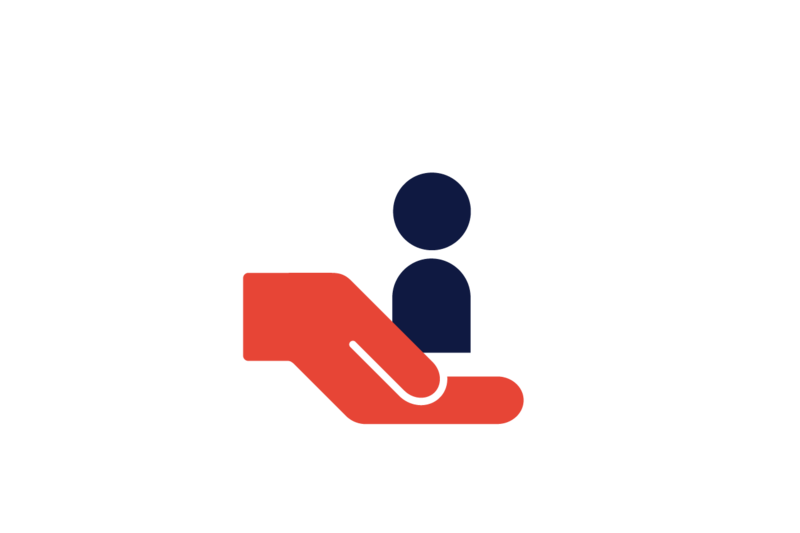Today’s manufacturing, automotive and logistics businesses share a common challenge — lack of workers. While the pandemic may have fuelled the global labour shortage, the motivations behind the large-scale resignations remain the same: job dissatisfaction, lack of engagement and financial considerations.
More than ever, companies need to develop and fine-tune workforce management solutions that recruit and retain talent. Fortunately, our team at Randstad not only specialises in recruitment strategies but also provides contingent workforce management, including onboarding, training and flexible shift planning.
Here’s a look at some of the ways Randstad Inhouse Services can help improve your workforce retention and contingent talent management.
learn more about improving your workforce retention rates.

offer competitive salaries
In today’s uncertain economy, more and more businesses are looking for ways to trim budgets. You may think the last thing your company can offer is higher salaries. However, if your current salary levels aren’t competitive enough to attract and retain top talent, you may be losing more than the cost of a salary increase.
New benchmarking data from the Society for Human Resource Management suggests an average cost per hire of $4,700. But that’s only the bottom line figure. It doesn’t consider soft costs like how much time managers spend with HR personnel, detailing what they need and reviewing suggested candidates. Or how about the loss of productivity while you’re minus a person, or when you’re getting the replacement employee up to speed? SHRM postulates you could be spending three to four times the cost of the salary on the new individual.
In the end, a pay increase could provide much greater savings to the company compared to the recruitment and onboarding costs of replacing workers dissatisfied with salaries. Our Randstad team can show you how to offset salary increases with other workforce solutions to ensure the most cost-effective use of your payroll dollars.
Certainly, the right salary can give your company a competitive edge when recruiting new talent, but is it enough to prevent your top employees from leaving? Studies suggest it is.
While motivators like flexible scheduling, meaningful work and similar social values are attractive to employees, money is still a prime motivator. According to the Global Workforce Hope and Fears Survey 2022 by PwC, 71% of workers claimed pay was the most important factor when changing jobs. Furthermore, 35% of workers plan to request a raise in the next year.
Rising inflation fuelled by the supply chain disruption, the pandemic and the conflict between Ukraine and Russia is making it difficult for people to maintain their current standard of living. As a result, employees who may be happy at their jobs have no choice but to look for a higher-paying situation to provide for themselves and their families.
Now’s the time to look at your company’s cost of living raises and see if you’re meeting the needs of your employees. By proactively dealing with employee expectations and effectively communicating pay policies, you may be able to prevent the loss of a valuable employee.
boost your employer brand and reputation
Gallup’s State of the Global Workplace 2022 surveyed workers in 96 countries to discover how they rate their mental health and how it compares to how they feel about their job. Sadly, just over a fifth of the workforce feel engaged at work, and correspondingly only a third of the people surveyed feel they are thriving in life.
While many businesses in the manufacturing, automotive and logistics sectors have taken great strides in improving employee engagement levels, others have struggled. In some cases, the reason that companies' efforts aren’t boosting employee-perceived engagement is that employers have trouble fully understanding their workers’ needs.
Our team at Randstad has noticed this employer-employee disconnect for years, which is why our workforce management solutions include comprehensive employer branding research and analysis. Through extensive industry and company-specific research, we can provide valuable insights to help you better understand the needs of new candidates as well as your current workforce.
With these key insights in hand, your team will have access to the tools and data it needs to build a benefits package that not only attracts top talent in the industry, but also entices your current workers to stay longer. This, in turn, can help boost employee engagement as you build an employer brand that drives results and improves the company’s reputation with former, current and potential employees.
In addition to lowering turnover rates, improved employee engagement levels have also been known to increase productivity and reduce absenteeism and safety issues. According to collective database results from Gallup, an analytic and advice firm, companies with high engagement levels are more productive by 14% in production, 18% in sales and have a 23% increase in profitability, giving you more than enough reason to devote resources to employee engagement and workforce retention.
Quote ‘Improved employee engagement levels have also been known to increase productivity and reduce absenteeism and safety issues.’
improve onboarding efforts to speed up acclimation
In a separate report, Gallup studied the onboarding process. The company found that the employee experience can be compared to a journey composed of several stages: attraction, job acceptance, onboarding, engagement, performance, development and finally a positive exit.
Why is the onboarding step so critical to contingent workforce management? During the onboarding process, the employee affirms their decision to accept the job. They then proceed to the next stop along the journey — engagement.
However, if there is a problem during onboarding, the employee may ‘too quickly’ decide the job isn’t for them. As a result, you will lose them before they even have a chance to engage.
If this happens repeatedly, it can ultimately cost your company thousands or tens of thousands of dollars annually. And to further complicate things, if your contingent workforce pool is inadequate, you won’t be able to meet production quotas.
The good news is that there is a direct link between onboarding and job satisfaction. Gallup discovered that employees who received a great onboarding experience were more likely to be extremely satisfied at work — over 2.6 times.
For best results, onboarding should begin on day one, as in the day the new hire accepts the position. This step might include a simple welcome letter that contains more information about the company and workplace culture or requires the employee to complete new hire paperwork. Once the employee is on the job, there should be a comprehensive onboarding process that highlights company values and helps to acclimate the new hire as quickly and efficiently as possible.
Randstad can handle the entire onboarding experience for you. However, we understand that every company has unique pain points and requirements. Therefore, we offer customised solutions that allow you to determine which parts of the onboarding operation you want our team to handle and which parts you want to keep in-house.
For example, hybrid and remote work models are here to stay, which may affect some of your onboarding processes. It’s critical that new employees connect with their managers, so take advantage of apps and software that enable the transfer of knowledge along with sharing and camaraderie.
No matter what level of direct services your company needs, we can help you develop an onboarding process that improves employee engagement levels, speeds up the acclimation process and entices your new hires to move on to the next stage of their journey.

hire the right talent from the start
One of the best ways to reduce turnover rates is to hire the right talent from the start. Consider all the time and money you invest into recruiting and onboarding new hires. The last thing you want to do is wait until the onboarding process is over to realise that the new hire is not a good fit for the position or the company.
You can improve hiring outcomes by creating a more stringent hiring process. At first glance, developing more selective hiring tactics may seem counterproductive when you’re having trouble finding skilled workers. However, the alternative is to remain in the never-ending cycle of high turnover and poor performance, or risk hiring toxic employees that drive out some of your best talent.
Consider upcoming changes, such as digitalisation and automation, when choosing new workers. With Industry 4.0 transforming the manufacturing, logistics and automotive industries, the last thing you need is to hire and onboard a worker whose role will soon be obsolete. However, by hiring workers who have the potential to master new skills, you’ve set yourself up for reskilling success. Reskilling is a cost-effective way to use current talent to handle new tasks, helping you cover future skills gaps in your industry.
Unlike some of our competitors, Randstad never offers one-size-fits-all hiring solutions. Instead, we take the time to understand industry trends and company-specific insights, including your workplace culture, business processes, hiring needs and goals.
We use this valuable analytical data to develop a stringent hiring process that not only attracts skilled workers, but also identifies which candidates are a good fit for your company and the position. This process, in turn, results in better hiring outcomes, including retention rates.
utilise comprehensive contingent workforce management solutions
If your business depends upon a large contingent workforce, consider partnering with Randstad Inhouse Services. We’ll handle the day-to-day responsibilities of workforce management, leaving you free to work on upper-level tasks. Our team consists of a commercial manager, process manager and account specialist, as well as access to our support team of legal, compliance and health and safety experts. In addition, you’ll also be connected with an onsite consultant, who can handle various issues throughout the day and provide professional guidance as needed.
Randstad can handle everything from recruitment and selection to onboarding and induction to shift planning and forecasting. We’ll work directly with you to determine which aspects of contingent workforce management you want our team to handle.
Allowing our team to be responsible for some or all these tasks will give your in-house team more time to focus on building employee relations and strengthening your company culture.
If your company is struggling to find the skilled workers it needs to remain productive, prioritising employee retention can be an effective solution. Find out how Randstad helped one company improve overall retention rates while lowering workforce costs at the same time.

(This is an updated version of an article originally published on 16 December 2021.)





